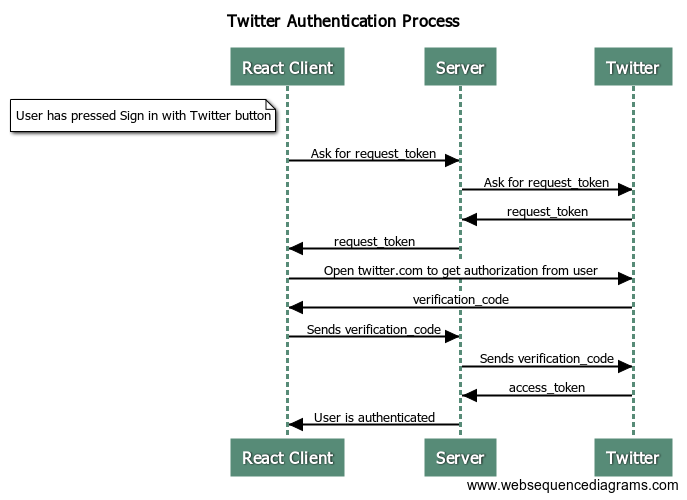@22u/react-twitter-auth 中文文档教程
React Twitter Authentication Component
用于 React
Installation
npm install 的 React Twitter oAUth 登录/登录组件react-twitter-auth
Usage
```jsx 和谐
Custom content that overrides default content:
jsx 和谐
Options
| params | value | default value | description |
|---|---|---|---|
| tag | string | button | tag that should be used to create element that will be used as loging element |
| text | string | Sign in with Twitter | text that will be shown in component |
| loginUrl | string | URL that will be used to finish 3rd step of authentication process | |
| requestTokenUrl | string | URL that will be used to get request token | |
| onFailure | function | function that will be called if user cannot be authenticated | |
| onSuccess | function | function that will be called if user is successfully authenticated | |
| disabled | boolean | false | disable component |
| style | object | style object | |
| className | string | class name for component | |
| dialogWidth | number | 600 | dialog width |
| dialogHeight | number | 400 | dialog height |
| showIcon | bool | true | should default icon be visible |
| credentials | string | same-origin | indicates whether the user agent should send cookies from the other domain in the case of cross-origin requests. Possible values: omit, same-origin, include |
| customHeaders | object | {} | custom headers should be object with fields that needs to be sent to user server. Field name will be used as header key and field value as header value. Because of bug in fetch implementation all keys will be lowercase. |
| children | node | this props can be used in order to override default component content |
Examples
完整示例可以在 example 文件夹中找到。
您可以找到详细说明如何使用 RESTful 后端实施 Twitter 身份验证的教程 此处。
Workflow
整个过程的详细解释可以在推特文档中找到。 在下图中,您可以找到所需的所有步骤。

License
react-twitter-auth 在MIT 许可证。
React Twitter Authentication Component
A React Twitter oAUth Sign-in / Log-in Component for React
Installation
npm install react-twitter-auth
Usage
```jsx harmony
Custom content that overrides default content:
jsx harmony
Options
| params | value | default value | description |
|---|---|---|---|
| tag | string | button | tag that should be used to create element that will be used as loging element |
| text | string | Sign in with Twitter | text that will be shown in component |
| loginUrl | string | URL that will be used to finish 3rd step of authentication process | |
| requestTokenUrl | string | URL that will be used to get request token | |
| onFailure | function | function that will be called if user cannot be authenticated | |
| onSuccess | function | function that will be called if user is successfully authenticated | |
| disabled | boolean | false | disable component |
| style | object | style object | |
| className | string | class name for component | |
| dialogWidth | number | 600 | dialog width |
| dialogHeight | number | 400 | dialog height |
| showIcon | bool | true | should default icon be visible |
| credentials | string | same-origin | indicates whether the user agent should send cookies from the other domain in the case of cross-origin requests. Possible values: omit, same-origin, include |
| customHeaders | object | {} | custom headers should be object with fields that needs to be sent to user server. Field name will be used as header key and field value as header value. Because of bug in fetch implementation all keys will be lowercase. |
| children | node | this props can be used in order to override default component content |
Examples
Full example can be found in example folder.
You can find tutorial that explains in details how to implement Twitter authentication with RESTful backend here.
Workflow
The detailed explanation of the whole process can be found in Twitter documentation. In picture below you can find out all the steps that are needed.

License
react-twitter-auth is released under MIT License.



